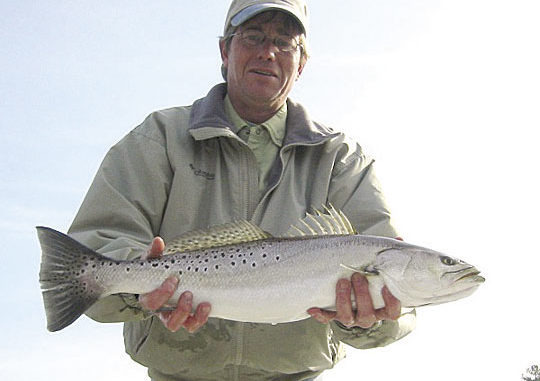
Often overlooked by fishermen targeting speckled trout, the Pungo is an angler’s heaven.
Not as renowned as the Neuse or the Roanoke, the Pungo River is a prolific fishery loaded with pristine shorelines and waters that are rich in speckled trout. Early Native Americans identified it as “matcha punga” or the “river of many fish.”The name stuck, and the river continues to maintain its rich heritage. Although relatively remote, the Pungo is a great fishing destination hidden deep in the headwaters of the Pamlico Sound.
The influx of fresh and salt waters, as well as a high variation in depths, creates every condition available for fish and plant species utilizing the area. The river and the Pamlico Sound contain thousands of acres of premier habitat important to more than 75 species of finfish and shellfish. More than 5,500 acres of the sound is designated as fish nursery grounds.
The Pungo’s undisturbed shorelines and brackish waters create ideal conditions for juvenile shrimp, baitfish and schools of speckled trout. Anglers who regularly fish the Pungo and other western tributaries of the sound get excited during late spring when the spawn approaches. As waters warm, speckled trout begin their annual mating rituals in May and will spawn during each full moon and new moon through July.
Capt. George Beckwith of Down East Guide Service targets everything from American shad on the Roanoke River to roosterfish in Costa Rica, but speckled trout are second nature for him. Along with many years guiding on the Pamlico Sound, Beckwith’s educational background as a marine biologist and his love for the resource has fully developed his understanding of many species of fish, including the elusive speckled trout.
“While many (trout) move into the ocean to overwinter, others migrate up the creeks into deeper, temperature stable environments,” he said. “As waters warm in spring, both groups of fish return, co-mingling in the sound to feed and begin spawning as early as May in the sound and its tributaries.”
The Pungo and neighboring systems are dynamic, changing significantly as weather patterns shift. Salinity is the single most-limiting factor for specks, which are sensitive to changes in salinity, altering their movements. Although the Pungo and neighboring rivers are not influenced by moon tides, wind tides play a big role and are the primary source for changes in salinity and trout movements in summer.
Wind tides also directly affects water levels. Other than the main river channel, the Pungo is relatively shallow, and changes in water levels significantly change the way the river fishes. Often, trout will prefer certain depths around submerged vegetation and structure or just bare flats. Wind tides create conditions that drastically change the places where specks hold during the summer. Prime areas can dry up quickly and drastically, sending anglers on a search to locate new hideouts. Luckily, trout will move to places with the depth and salinity they prefer, and often, will not be too far away from earlier locales.
“Optimal spawning occurs during the summer months in the lower parts of the river, with higher salinity,” Beckwith said.
Speckled trout are sensitive to small changes in temperature and salinity, especially during the spawning period.
Capt. Mark Charles Hoff of Sweetwater Charters started guided in the western Pamlico Sound more than 16 years ago, and he targets speckled trout throughout the year. Based out of Oriental, Hoff chases large schools of trout during the prespawn and spawning periods.
“Trout are ganged up just before each spawning cycle, and we catch them real good,” he said. “Trout move out of the creeks and will stage at the mouths of creeks and along breaks extending from the shoreline. “
Speckled trout spawn just after dusk through the night in shallow bays with grassy cover. Hoff seeks the tightly-grouped schools of trout just before spawning.
“These fish will slip out of the deeper areas up on flats to attack schools of bait,” he said. “We generally can see an oily sheen slicked across the surface on the edges of depth breaks, identifying the locations of feeding trout early in the morning and late in the afternoons.”
The oily sheen is the by-product of gangs of trout blistering schools of menhaden. Hoff skims the edges of these breaks, looking for a different appearance on the surface. He prefers deeper flats three to four feet deep that extend from the bank out 30 yards and drop to seven to eight feet. Trout will hold in the deeper water and will cruise the flat, gobbling up shrimp, menhaden, and other baitfish.
Beckwith often finds speckled trout feeding on shallow flats in less than two feet of water. The shallower the water, the more stealthy approach is needed. Anglers should anticipate where fish are going to be and try to get just close enough to make an accurate cast.
“A quiet trolling motor in combination with a shallow-water anchor such as a Power Pole are ideal to slip up on a hot flat with feeding fish,” Beckwith said. “Many anglers don’t realize how shallow these fish will actively be feeding.”
In the summer, Pungo fishing is predominantly a early and late activity. Specks will go on a feeding frenzy just after daylight and just before dark.
“As the sun comes up, trout retreat back to deeper waters and are tough to catch,” Hoff said.
Beckwith looks for slightly deeper water with structure and will fish tight to the structure near deeper drop-offs during the middle of the day. He also pays attention to man-made pieces of structure such as boat docks and duck blinds.
“Be sure to include obscure pieces of structure in deeper waters such as lone pilings and channel markers,” Beckwith said.
Finding these hotspots in the Pungo and neighboring rivers is dependant on water conditions, with salinity remaining the key factor.
“During periods of high salinity, trout will move up the river beyond Belhaven towards Scranton Creek and conversely will be found towards the mouth at the confluence with the Pamlico River,” Beckwith said.
The sleepy town of Belhaven is a good place to start. Located at the confluence of Pantego Creek and the Pungo River, Belhaven is at the mid-point of the entire reach of river from Ponzer to its confluence with the Pamlico River at Wades Point. A public boating access area on East Water St. offers anglers a good, deep ramp and quick access to summer trout hotspots. The stretch in Belhaven is littered with docks, rocks, and other structures in deeper waters near the mouth of Pantego Creek — perfect for finding hungry specks busting bait on shallow bars around the spawn. Beyond Belhaven, the mouths of Slade Creek and Pungo Creek offer good fishing as well.
Lures and baits for catching Pungo trout are typical imitations to their primary food sources: menhaden, mullet, small spots and croakers in the western Pamlico. The forage fish are omnivorous but tend to be mostly filter-feeding vegetarians in the Pungo. Shrimp are always the preferred prey of trout, but low salinity levels in the river offer poor conditions for them.
As the waters heat up significantly, nutrient loads in the Pungo produce huge algal blooms that provide an unlimited food source for baitfish, whose populations explode and provide speckled trout with a primary food source.
Beckwith fishes topwater baits, specifically a Zara Spook, early in the morning along flats near drops. After the sun rises, he will switch to an eighth- or quarter-ounce jig head and a Berkley Gulp! or Fin-S soft-plastic jerkbait. He uses the heavier jighead in deeper waters or during windy conditions. He prefers a slow fall but wants to be able to feel the bottom.
Hoff also prefers light jigheads in the same size ranges and will work the lures back very slowly, with small stops along the way.
“When throwing jigs, a very slow fall is most important,” he said.
Waters in the Pungo are often heavily-stained, and lure colors are less important. Trial-and-error is usually the tactic, as preferred colors can change throughout the season. Hoff prefers dark baits under dark conditions and lighter colors during bright, sunny conditions.
Often, the productive drop-offs are covered with submerged vegetation. Hoff will use a popping cork to suspend his jig/grub combination over the grass. Beckwith also utilizes floats, but he generally floats live bait away from the immediate shoreline.
“As I move down the bank, I have a live bait on a cork trailing behind the boat. Trout schools are often passed over by folks concentrating on the shoreline, when they need to be casting in front of and behind the boat, 30 to 100 feet off the shoreline,” said Beckwith, who will use live baits on a Carolina rig with a short, 1-foot leader, and enough weight to keep the bait fish struggling on the bottom.

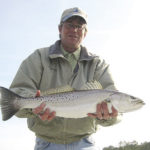
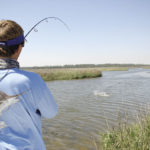
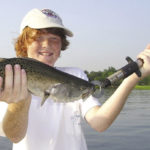
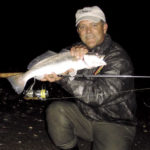
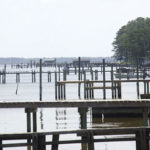



Be the first to comment